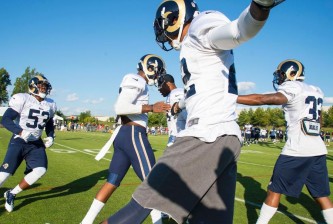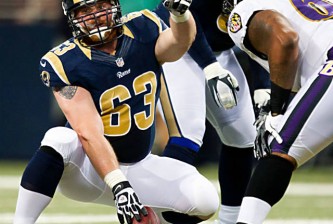Part 2: The brain disease the NFL wished would simply go away
The skull generally does a pretty good job of protecting the brain, encasing it in hard bone and the forgiveness of spinal fluid. And when it gets bruised, as it does by a concussion, the resulting disorientation should be enough to encourage us to lay back and heal. But the evolution of professional sports — and football in particular — have made the brain’s defenses seem pretty futile.
On every snap, in every practice, offensive and defensive linemen spring from their crouches and bang their heads together, as fans and coaches on the sidelines applaud, wanting to hear the pads pop. Each hit results in 20 to 30 g’s, rattling and shearing the brain in its capsule. Then they line up and do it again, thousands of times per year. Not every hit leads to a concussion; they don’t have to. The frayed fibers and built-up scar tissue from these thousands of hits do plenty of damage on their own.

Dr. Bennet Omalu: the man whose research became anathema to the league.
Part 1: Tackling the Unknown.
Part 2: The Disease the NFL Wanted to go Away.
Part 3: A Light in the Darkness.
Jeanne Marie Laskas wrote a fascinating article for GQ in 2009, charting the discovery and emerging science of CTE in NFL players, which was pioneered by a neuropathologist named Bennet Omalu, and by the brain of Mike Webster.
“What the mind does not know, the eye cannot see,” he would say, explaining the piles of books and journal articles cluttering the house, the sheer volume of research on trauma, on football, on helmets, on Alzheimer’s disease, on concussions, on impact, on g-force, on protein accumulation, on dementia pugilistica. He had to learn more so he could see more so he could learn more so he could see. For months it’s all he thought about. It became for him a calling.
He was after all a spiritual man, and he came to know Mike Webster in the most personal way. “Help me” is what he heard Mike Webster say.
What Omalu found was a staggeringly high concentration of tau proteins in the former Steeler’s brain matter, at levels never seen before in a 45-year-old man. Even if it were a 90-year-old’s brain with severe Alzheimer’s, the numbers would have been off the charts. In 2005, Omalu submitted his findings in the well-respected Neurosurgery journal, and suddenly found himself the public enemy #1 of the NFL’s own brain scientists.
The league had funded a committee to study Mild Traumatic Brain Injuries (MTBI) since 1994. But until the publication of Omalu’s work eleven years later, the league still had no official policy on the treatment of concussed players. In fact, up until that point, the MTBI had no neuroscientists on its council, and had found absolutely no link between concussions and the health issues of its retired players.
The MTBI committee published scientific studies claiming that repeated head bashing did not cause brain damage. On a 2007 HBO special, co-chair Casson was asked six different ways if repeated football-related concussions could result in brain damage, dementia, or depression. Six times he said no.
By this point, serious neuroscientists had already realized that the study of brain diseases like Alzheimer’s was too large, too complex, for the old world method of study — small teams behind closed doors using “different methods on different subjects in different places and getting different results.” A few key members of the scientific field did an abrupt 180, opening their research in real time to the community at large, knowing that they would need to throw as many smart people as possible at the problem in order to solve it.
The key to the Alzheimer’s project was an agreement as ambitious as its goal: not just to raise money, not just to do research on a vast scale, but also to share all the data, making every single finding public immediately, available to anyone with a computer anywhere in the world.
“It was unbelievable,” said Dr. John Q. Trojanowski, an Alzheimer’s researcher at the University of Pennsylvania. “It’s not science the way most of us have practiced it in our careers. But we all realized that we would never get [results] unless all of us parked our egos and intellectual-property noses outside the door and agreed that all of our data would be public immediately.”
— New York Times: Rare Sharing of Data Leads to Progress on Alzheimer’s
It took time, but the NFL eventually followed a similar course. In 2007, Roger Goodell demanded that the MTBI committee change its ways, and open its doors to outside research. However, those open doors have only facilitated an epic (and still ongoing) shouting match between the researchers on the NFL’s payroll and the scientific community at large.
Even as the league has decided to hedge its bets by implementing concussion treatment guidelines and baseline brain tests for each player, and by cracking down on flagrant offenses, there has yet to be an official acknowledgement of CTE, or the NFL’s potential responsibility in preventing it.
As of Laskas’ 2009 article, Ira Casson was still co-director of the MTBI committee, and was still unconvinced of any connection between the tens of thousands of helmet-to-helmet collisions sustained by a lineman over his career, and any subsequent dementia.
“Nothing has happened that has changed any of our opinions about what we wrote in those letters. Is there a relationship between professional football, a career in the NFL, and changes in the brain? Well, we don’t know. Maybe.”
Read Part 3: The NFL’s Light in the Darkness: The ’88 Plan’






















